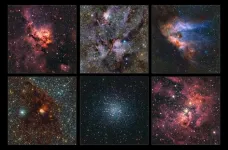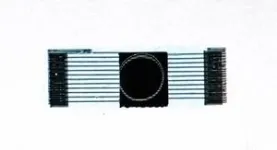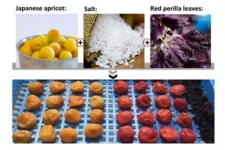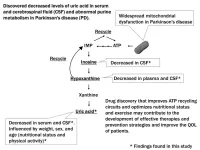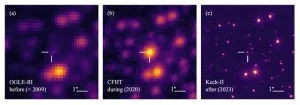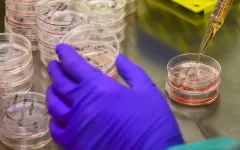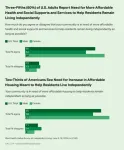(Press-News.org) Astronomers have published a gigantic infrared map of the Milky Way containing more than 1.5 billion objects ― the most detailed one ever made. Using the European Southern Observatory’s VISTA telescope, the team monitored the central regions of our Galaxy over more than 13 years. At 500 terabytes of data, this is the largest observational project ever carried out with an ESO telescope.
“We made so many discoveries, we have changed the view of our Galaxy forever,” says Dante Minniti, an astrophysicist at Universidad Andrés Bello in Chile who led the overall project.
This record-breaking map comprises 200 000 images taken by ESO’s VISTA ― the Visible and Infrared Survey Telescope for Astronomy. Located at ESO’s Paranal Observatory in Chile, the telescope’s main purpose is to map large areas of the sky. The team used VISTA’s infrared camera VIRCAM, which can peer through the dust and gas that permeates our galaxy. It is therefore able to see the radiation from the Milky Way’s most hidden places, opening a unique window onto our galactic surroundings.
This gigantic dataset [1] covers an area of the sky equivalent to 8600 full moons, and contains about 10 times more objects than a previous map released by the same team back in 2012. It includes newborn stars, which are often embedded in dusty cocoons, and globular clusters –– dense groups of millions of the oldest stars in the Milky Way. Observing infrared light means VISTA can also spot very cold objects, which glow at these wavelengths, like brown dwarfs (‘failed’ stars that do not have sustained nuclear fusion) or free-floating planets that don’t orbit a star.
The observations began in 2010 and ended in the first half of 2023, spanning a total of 420 nights. By observing each patch of the sky many times, the team was able to not only determine the locations of these objects, but also track how they move and whether their brightness changes. They charted stars whose luminosity changes periodically that can be used as cosmic rulers for measuring distances [2]. This has given us an accurate 3D view of the inner regions of the Milky Way, which were previously hidden by dust. The researchers also tracked hypervelocity stars — fast-moving stars catapulted from the central region of the Milky Way after a close encounter with the supermassive black hole lurking there.
The new map contains data gathered as part of the VISTA Variables in the Vía Láctea (VVV) survey [3] and its companion project, the VVV eXtended (VVVX) survey. “The project was a monumental effort, made possible because we were surrounded by a great team,” says Roberto Saito, an astrophysicist at the Universidade Federal de Santa Catarina in Brazil and lead author of the paper published today in Astronomy & Astrophysics on the completion of the project.
The VVV and VVVX surveys have already led to more than 300 scientific articles. With the surveys now complete, the scientific exploration of the gathered data will continue for decades to come. Meanwhile, ESO’s Paranal Observatory is being prepared for the future: VISTA will be updated with its new instrument 4MOST and ESO's Very Large Telescope (VLT) will receive its MOONS instrument. Together, they will provide spectra of millions of the objects surveyed here, with countless discoveries to be expected.
Notes
[1] The dataset is too large to release as a single image, but the processed data and objects catalogue can be accessed in the ESO Science Portal.
[2] One way to measure the distance to a star is by comparing how bright it appears as seen from Earth to how intrinsically bright it is; but the latter is often unknown. Certain types of stars change their brightness periodically, and there is a very strong connection between how quickly they do this and how intrinsically luminous they are. Measuring these fluctuations allows astronomers to work out how luminous these stars are, and therefore how far away they lie.
[3] Vía Láctea is the Latin name for the Milky Way.
More information
This research was presented in a paper entitled “The VISTA Variables in the Vía Láctea eXtended (VVVX) ESO public survey: Completion of the observations and legacy” published in Astronomy & Astrophysics (https://doi.org/10.1051/0004-6361/202450584). Data DOI: VVV, VVVX.
The team is composed of R. K. Saito (Departamento de Física, Universidade Federal de Santa Catarina, Florianópolis, Brazil [UFSC]), M. Hempel (Instituto de Astrofísica, Dep. de Ciencias Físicas, Facultad de Ciencias Exactas, Universidad Andres Bello, Providencia, Chile [ASTROUNAB] and Max Planck Institute for Astronomy, Heidelberg, Germany), J. Alonso-García (Centro de Astronomía, Universidad de Antofagasta, Antofagasta, Chile [CITEVA] and Millennium Institute of Astrophysics, Providencia, Chile [MAS]), P. W. Lucas (Centre for Astrophysics Research, University of Hertfordshire, Hatfield, United Kingdom [CAR]), D. Minniti (ASTROUNAB; Vatican Observatory, Vatican City, Vatican City State [VO] and UFSC), S. Alonso (Departamento de Geofísica y Astronomía, CONICET, Facultad de Ciencias Exactas, Físicas y Naturales, Universidad Nacional de San Juan, Rivadavia, Argentina [UNSJ-CONICET]), L. Baravalle (Instituto de Astronomía Teórica y Experimental, Córdoba, Argentina [IATE-CONICET]; Observatorio Astronómico de Córdoba, Universidad Nacional de Córdoba, Argentina [OAC]), J. Borissova (Instituto de Física y Astronomía, Universidad de Valparaíso, Valparaíso, Chile [IFA-UV] and MAS), C. Caceres (ASTROUNAB), A. N. Chené (Gemini Observatory, Northern Operations Center, Hilo, USA), N. J. G. Cross (Wide-Field Astronomy Unit, Institute for Astronomy, University of Edinburgh, Royal Observatory, Edinburgh, United Kingdom), F. Duplancic (UNSJ-CONICET), E. R. Garro (European Southern Observatory, Vitacura, Chile [ESO Chile]), M. Gómez (ASTROUNAB), V. D. Ivanov (European Southern Observatory, Garching bei München [ESO Germany]), R. Kurtev (IFA-UV and MAS), A. Luna (INAF – Osservatorio Astronomico di Capodimonte, Napoli, Italy [INAF- OACN]), D. Majaess (Mount Saint Vincent University, Halifax, Canada), M. G. Navarro (INAF – Osservatorio Astronomico di Roma, Italy [INAF-OAR]), J. B. Pullen (ASTROUNAB), M. Rejkuba (ESO Germany), J. L. Sanders (Department of Physics and Astronomy, University College London, London, United Kingdom), L. C. Smith (Institute of Astronomy, University of Cambridge, Cambridge, United Kingdom), P. H. C. Albino (UFSC), M. V. Alonso (IATE-CONICET and OAC), E. B. Amôres (Departamento de Física, Universidade Estadual de Feira de Santana, Feira de Santana, Brazil), E. B. R. Angeloni (Gemini Observatory/NSF’s NOIRLab, La Serena, Chile [NOIRLab]), J. I. Arias (Departamento de Astronomía, Universidad de La Serena, La Serena, Chile [ULS]), M. Arnaboldi (ESO Germany), B. Barbuy (Universidade de São Paulo, São Paulo, Brazil), A. Bayo (ESO Germany), J. C. Beamin (ASTROUNAB and Fundación Chilena de Astronomía, Santiago, Chile), L. R. Bedin (Istituto Nazionale di Astrofisica, Osservatorio Astronomico di Padova, Padova, Italy [INAF-OAPd]), A. Bellini (Space Telescope Science Institute, Baltimore, USA [STScI]), R. A. Benjamin (Department of Physics, University of Wisconsin-Whitewater, Whitewater, USA), E. Bica (Departamento de Astronomia, Instituto de Física, Porto Alegre, Brazil [IF – UFRGS]), C. J. Bonatto (IF – UFRGS), E. Botan (Instituto de Ciências Naturais, Humanas e Sociais, Universidade Federal de Mato Grosso, Sinop, Brazil), V. F. Braga (INAF-OAR), D. A. Brown (Vatican Observatory, Tucson, USA), J. B. Cabral (IATE-CONICET and Gerencia De Vinculación Tecnológica, Comisión Nacional de Actividades Espaciales, Córdoba, Argentina), D. Camargo (Colégio Militar de Porto Alegre, Ministério da Defesa, Exército Brasileiro, Brazil), A. Caratti o Garatti (INAF- OACN), J. A. Carballo-Bello (Instituto de Alta Investigación, Universidad de Tarapacá, Arica, Chile [IAI-UTA]), M.Catelan (Instituto de Astrofísica, Pontificia Universidad Católica de Chile, Santiago, Chile [Instituto de Astrofísica UC]; MAS and Centro de Astro-Ingeniería, Pontificia Universidad Católica de Chile, Santiago, Chile [AIUC]), C. Chavero (OAC and Consejo Nacional de Investigaciones Científica y Técnicas, Ciudad Autónoma de buenos Aires, Argentina [CONICET]), M. A. Chijani (ASTROUNAB), J. J. Clariá (OAC and CONICET), G. V. Coldwell (UNSJ-CONICET), C. Contreras Peña (Department of Physics and Astronomy, Seoul National University, Seoul, Republic of Korea and Research Institute of Basic Sciences, Seoul National University, Seoul, Republic of Korea), C. R. Contreras Ramos (Instituto de Astrofísica UC and MAS), J. M. Corral-Santana (ESO Chile), C. C. Cortés (Departamento de Tecnologías Industriales, Faculty of Engineering, Universidad de Talca, Curicó, Chile), M. Cortés-Contreras (Departamento de Física de la Tierra y Astrofísica & Instituto de Física de Partículas y del Cosmos de la UCM, Facultad de Ciencias Físicas, Universidad Complutense de Madrid, Madrid, Spain), P. Cruz (Centro de Astrobiología, CSIC-INTA, Madrid, Spain [CAB]), I. V. Daza-Perilla (CONICET; IATE-CONICET and Facultad de Matemática, Astronomía, Física y Computación, Universidad Nacional de Córdoba, Córdoba, Argentina), V. P. Debattista (University of Central Lancashire, Preston, United Kingdom), B. Dias (ASTROUNAB), L. Donoso (Instituto de Ciencias Astronómicas, de la Tierra y del Espacio, San Juan, Argentina), R. D’Souza (VO), J. P. Emerson (Astronomy Unit, School of Physical and Chemical Sciences, Queen Mary University of London, London, United Kingdom), S. Federle (ESO Chile and ASTROUNAB), V. Fermiano (UFSC), J. Fernandez (UNSJ-CONICET), J. G. Fernández-Trincado (Instituto de Astronomía, Universidad Católica del Norte, Antofagasta, Chile [IA-UCN]), T. Ferreira (Department of Astronomy, Yale University, New Haven, USA), C. E. Ferreira Lopes (Instituto de Astronomía y Ciencias Planetarias, Universidad de Atacama, Copiapó, Chile [INCT] and MAS), V. Firpo (NOIRLab), C. Flores-Quintana (ASTROUNAB and MAS), L. Fraga (Laboratorio Nacional de Astrofísica, Itajubá, Brazil), D.Froebrich (Centre for Astrophysics and Planetary Science, School of Physics and Astronomy, University of Kent, Canterbury, United Kingdom), D. Galdeano (UNSJ-CONICET), I. Gavignaud (ASTROUNAB), D. Geisler (Departamento de Astronomía, Universidad de Concepción, Chile [UdeC]; Instituto Multidisciplinario de Investigación y Postgrado, Universidad de La Serena, Chile [IMIP-ULS] and ULS), O. E.Gerhard (Max Planck Institute for Extraterrestrial Physics, Germany [MPE]), W. Gieren (UdeC), O. A. Gonzalez (UK Astronomy Technology Centre, Royal Observatory Edinburgh, Edinburgh, United Kingdom), L. V. Gramajo (OAC and CONICET), F. Gran (Université Côte d’Azur, Observatoire de la Côte d’Azur, CNRS, Laboratoire Lagrange, Nice, France [Lagrange]), P. M. Granitto (Centro Internacional Franco Argentino de Ciencias de la Información y de Sistemas, Rosario, Argentina), M. Griggio (INAF-OAPd; Dipartimento di Fisica, Università di Ferrara, Ferrara, Italy and STScI), Z. Guo (IFA-UV and MAS), S. Gurovich (IATE-CONICET and Western Sydney University, Kingswood, Australia), M. Hilker (ESO Germany), H. R. A. Jones (CAR), R. Kammers (UFSC), M. A. Kuhn (CAR), M. S. N. Kumar (Centro de Astrofísica da Universidade do Porto, Porto, Portugal), R. Kundu (Miranda House, University of Delhi, India and Inter University centre for Astronomy and Astrophysics, Pune, India), M. Lares (IATE-CONICET), M. Libralato (INAF-OAPd), E. Lima (Universidade Federal do Pampa, Uruguaiana, Brazil), T. J. Maccarone (Department of Physics & Astronomy, Texas Tech University, Lubbock, USA), P. Marchant Cortés (ULS), E. L. Martin (Instituto de Astrofisica de Canarias and Departamento de Astrofísica, Universidad de La Laguna, San Cristóbal de la Laguna, Spain), N. Masetti (Istituto Nazionale di Astrofisica, Osservatorio di Astrofisica e Scienza dello Spazio di Bologna, Bologna, Italy and ASTROUNAB), N. Matsunaga (Department of Astronomy, Graduate School of Science, The University of Tokyo, Japan), F. Mauro (IA-UCN), I. McDonald (Jodrell Bank Centre for Astrophysics, The University of Manchester, UK [JBCA]), A. Mejías (Departamento de Astronomía, Universidad de Chile, Las Condes, Chile), V. Mesa (IMIP-ULS; Association of Universities for Research in Astronomy, Chile, Grupo de Astrofísica Extragaláctica-IANIGLA; CONICET, and Universidad Nacional de Cuyo, Mendoza, Argentina), F. P. Milla-Castro (ULS), J. H. Minniti (Department of Physics and Astronomy, Johns Hopkins University, Baltimore, USA), C. Moni Bidin (IA-UCN), K. Montenegro (Clínica Universidad de los Andes, Santiago, Chile), C. Morris (CAR), V. Motta (OAC), F. Navarete (SOAR Telescope/NSF’s NOIRLab, La Serena, Chile), C. Navarro Molina (Centro de Docencia Superior en Ciencias Básicas, Universidad Austral de Chile, Puerto Montt, Chile), F. Nikzat (Instituto de Astrofísica UC and MAS), J. L. NiloCastellón (IMIP-ULS and ULS), C. Obasi (IA-UCN and Centre for Basic Space Science, University of Nigeria, Nsukka, Nigeria), M. Ortigoza-Urdaneta (Departamento de Matemática, Universidad de Atacama, Copiapó, Chile), T. Palma (OAC), C. Parisi (OAC and IATE-CONICET), K. Pena Ramírez (NSF NOIRLab/Vera C. Rubin Observatory, La Serena, Chile), L. Pereyra (IATE-CONICET), N. Perez (UNSJ-CONICET), I. Petralia (ASTROUNAB), A. Pichel (Instituto de Astronomía y Física del Espacio, Ciudad Autónoma de Buenos Aires, Argentina [IAFE-CONICET]), G. Pignata (IAI-UTA), S. Ramírez Alegría (CITEVA), A. F. Rojas (Instituto de Astrofísica UC, Instituto de Estudios Astrofísicos, Facultad de Ingeniería y Ciencias, Universidad Diego Portales, Santiago, Chile and CITEVA), D. Rojas (ASTROUNAB), A. Roman-Lopes (ULS), A. C. Rovero (IAFE-CONICET), S. Saroon (ASTROUNAB), E. O. Schmidt (OAC and IATE-CONICET), A. C. Schröder (MPE), M. Schultheis (Lagrange), M. A. Sgró (OAC), E. Solano (CAB), M. Soto (INCT), B. Stecklum (Thüringer Landessternwarte, Tautenburg, Germany), D. Steeghs (Department of Physics, University of Warwick, UK), M. Tamura (Department of Astronomy, Graduate School of Science, University of Tokyo; Astrobiology Center, Tokyo, Japan, and National Astronomical Observatory of Japan, Tokyo, Japan), P. Tissera (Instituto de Astrofísica UC and AIUC), A. A. R. Valcarce (Departamento de Física, Universidad de Tarapacá, Chile), C. A. Valotto (IATE-CONICET and OAC), S. Vasquez (Museo Interactivo de la Astronomía, La Granja, Chile), C. Villalon (IATE-CONICET and OAC), S. Villanova (UdeC), F. Vivanco Cádiz (ASTROUNAB), R. Zelada Bacigalupo (North Optics, La Serena, Chile), A. Zijlstra (JBCA and School of Mathematical and Physical Sciences, Macquarie University, Sydney, Australia), and M. Zoccali (Instituto de Astrofísica UC and MAS).
The European Southern Observatory (ESO) enables scientists worldwide to discover the secrets of the Universe for the benefit of all. We design, build and operate world-class observatories on the ground — which astronomers use to tackle exciting questions and spread the fascination of astronomy — and promote international collaboration for astronomy. Established as an intergovernmental organisation in 1962, today ESO is supported by 16 Member States (Austria, Belgium, Czechia, Denmark, France, Finland, Germany, Ireland, Italy, the Netherlands, Poland, Portugal, Spain, Sweden, Switzerland and the United Kingdom), along with the host state of Chile and with Australia as a Strategic Partner. ESO’s headquarters and its visitor centre and planetarium, the ESO Supernova, are located close to Munich in Germany, while the Chilean Atacama Desert, a marvellous place with unique conditions to observe the sky, hosts our telescopes. ESO operates three observing sites: La Silla, Paranal and Chajnantor. At Paranal, ESO operates the Very Large Telescope and its Very Large Telescope Interferometer, as well as survey telescopes such as VISTA. Also at Paranal ESO will host and operate the Cherenkov Telescope Array South, the world’s largest and most sensitive gamma-ray observatory. Together with international partners, ESO operates ALMA on Chajnantor, a facility that observes the skies in the millimetre and submillimetre range. At Cerro Armazones, near Paranal, we are building “the world’s biggest eye on the sky” — ESO’s Extremely Large Telescope. From our offices in Santiago, Chile we support our operations in the country and engage with Chilean partners and society.
Links
Research paper
Photos of of the survey telescopes at Paranal, including VISTA
For journalists: subscribe to receive our releases under embargo in your language:
For scientists: got a story? Pitch your research
Contacts
Roberto K. Saito
Universidade Federal de Santa Catarina
Florianópolis, Brazil
Email: roberto.saito@ufsc.br
Dante Minniti
Universidad Andrés Bello
Santiago, Chile
Email: vvvdante@gmail.com
Phil Lucas
University of Hertfordshire
Hartfield, United Kingdom
Email: p.w.lucas@herts.ac.uk
Juan Carlos Muñoz-Mateos
ESO Media Officer
Garching bei München, Germany
Tel: +49 89 3200 6176
Email: press@eso.org
END
ESO telescope captures the most detailed infrared map ever of our Milky Way
2024-09-26
ELSE PRESS RELEASES FROM THIS DATE:
An edible toothpaste-based transistor
2024-09-26
Milan (Italy), 26 September 2024 - A toothpaste-based transistor is the latest innovation from the research team at the Istituto Italiano di Tecnologia (IIT-Italian Institute of Technology) in Milan, which pushes the boundaries of edible electronics. This innovative nano-device is expected to become a key component of future smart pills, designed to monitor health conditions from within the body and then safely dissolve after completing their function. The research findings have been published in the journal Advanced Science.
Several commercial toothpaste formulations contain crystals of copper phthalocyanine, a blue pigment that acts as a whitening ...
Increased antioxidants and phenolic compounds produced in salted red perilla leaves during Japanese apricot pickling
2024-09-26
The diverse biochemical composition of Japanese apricot fruits explains their broad spectrum of action on the human body. The high levels of key phenolic compounds and hydroxycinnamic acids contribute to various health benefits including anti-inflammatory, antioxidant, and antimicrobial properties.
A recent study published in Food Research International on July 19, 2024, led by Prof. Yukiharu Ogawa and Jutalak Suwannachot from Chiba University, quantitatively evaluated the changes in phenolic compounds and antioxidant activity during the production of Shiso-zuke Umeboshi (PP). The study also simulated the digestive process to characterize the release of these compounds and ...
Unlocking the energy crisis in Parkinson’s: New findings offer hope for future treatment
2024-09-26
Parkinson’s disease (PD), the second most common neurodegenerative disorder globally, has long baffled scientists with its progressive nature and debilitating effects on motor function.
A recent study from the School of Medicine at Fujita Health University has brought new insights into the metabolic disruptions experienced by patients with PD. By analyzing the blood and cerebrospinal fluid (CSF) of the patients, researchers have discovered critical impairments in purine metabolism and the recycling of adenosine triphosphate (ATP)—the molecule responsible for energy production in cells.
For years, scientists have noted the decreased levels ...
‘Weekend warrior’ physical activity may help protect against more than 200 diseases
2024-09-26
Busy with work and other obligations, some people concentrate their moderate-to-vigorous exercise in one or two days of the week or weekend. A study led by investigators at Massachusetts General Hospital, a founding member of the Mass General Brigham healthcare system, has found that this “weekend warrior” pattern of exercise is associated with lower risk of developing 264 future diseases and was just as effective at decreasing risk as more evenly distributed exercise activity. Results are published in Circulation.
“Physical activity is known to affect risk of many diseases,” said ...
People with unmedicated mental illness are less likely to be vaccinated against COVID-19
2024-09-26
Vaccination coverage for COVID-19 is high in both people with and without mental illness, according to a large multinational study led by researchers at Karolinska Institutet and published in Nature Communications. However, Swedish registry data revealed that individuals with unmedicated mental illness have lower vaccination levels.
The researchers analysed data from seven studies in five countries (Sweden, Norway, Iceland, Estonia, and Scotland) as part of the COVIDMENT consortium, totalling just over 325,000 individuals, and registry data from Sweden including over ...
This rocky planet around a white dwarf resembles Earth — 8 billion years from now
2024-09-26
The discovery of an Earth-like planet 4,000 light years away in the Milky Way galaxy provides a preview of one possible fate for our planet billions of years in the future, when the sun has turned into a white dwarf, and a blasted and frozen Earth has migrated beyond the orbit of Mars.
This distant planetary system, identified by University of California, Berkeley, astronomers after observations with the Keck 10-meter telescope in Hawaii, looks very similar to expectations for the sun-Earth system: it consists of a white dwarf about half the mass of the sun and an Earth-size companion in an orbit twice as large as Earth’s today.
That is likely to be Earth’s fate. ...
Study finds more than 80% of women iron deficient by third trimester
2024-09-26
Rockville, MD ̶ ̶ When a woman becomes pregnant, her iron requirements increase almost tenfold to support fetal development as well as her own increased iron needs. Her ability to meet these increased iron needs depends on her iron stores at the beginning of the pregnancy as well as the physiological adaptations that enhance iron absorption as pregnancy progresses. These physiological adaptations, however, are not always enough to support a pregnant woman’s iron needs, especially ...
4 in 5 pregnant women in Ireland are iron deficient by third trimester, study finds
2024-09-26
Four out of five pregnant women in Ireland are iron deficient by their third trimester, a University College Cork (UCC) study reveals. Researchers at the Irish Centre for Maternal and Child Health (INFANT) and School of Food and Nutritional Sciences in UCC have shown that over 80% of women are iron deficient by their third trimester.
The findings raise concerns as the participants in the study were a low-risk and generally healthy cohort. Iron deficiency during pregnancy is linked to increased risks of complications for both mother and child, including neurodevelopmental challenges for the baby.
This study is the largest of its kind globally and was ...
Researchers identify antibodies against Klebsiella pneumoniae
2024-09-26
Research at UMC Utrecht has identified 29 novel antibodies against the bacterium Klebsiella pneumoniae, an important cause of drug-resistant infections. Using genetic and functional approaches, the researchers also managed to unravel how these antibodies interact with antigens on the bacterial surface. Finally, they found that some of these novel antibodies act synergistically to neutralize this pathogen.
The increasing problem of antimicrobial resistance (AMR) urgently calls for the development of alternative ...
Housing, healthcare and social services top list of community needs as U.S. population ages
2024-09-26
WASHINGTON, D.C. — Sept. 26, 2024 — Most Americans agree their community is in need of more affordable housing, healthcare and social supports and services to help residents remain living independently as they age, according to a new survey from West Health and Gallup. Sixty-five percent of Americans perceive a need for more affordable housing and 60% say there is a need for more affordable healthcare and social supports and services.
The new West Health-Gallup research comes as the ...
